The researchers don’t know which ancient human species made the structure and the tools, but it’s unlikely to have been Homo sapiens. The earliest fossils of Homo sapiens found so far date from around 300,000 years ago and were found in Israel, Dull told CNN. He believes the people who made the structure were cognitively sophisticated and it would be very exciting to figure out who constructed this.



While radiocarbon dating is limited to about 50k years, there are other methods that work quite well. Potassium–argon dating can be used to date clay layers, but in more accurate for lava flows…
Other than that, you look for soil layers and look for global (or known local) events, then figure a date for those.
There can still be error, but less than you’d think. Tens of thousands of years at this scale, not hundreds.
There is always an error. The important thing (apart from eliminating bias) is to know the magnitude. Radio chronological analysis is well understood and laboratories can reliably report the magnitude of the error (or more specifically the uncertainty) accompanying any determination of age. But news articles rarely publish it.
In this case the age is quoted as “at least 476,000 years” so we can infer a precision estimate of plus or minus 1,000 years.